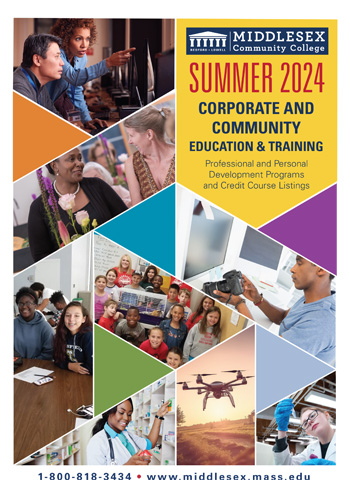Corporate Education & Workforce Training
it's our business to help your business
- Corporate Education & Workforce Training
- Areas of Expertise
- Management and Leadership
- Basic Skills
- Health Care
- Technology
- Training Needs Assessment
- Case Studies
- Workforce Training Grants
- Request Information
Telecommunications and Electronics Technology
Networking I and II
Session I: Addresses the concepts/ideas of LAN. Topologies, administration, security and data communications concepts are addressed. Session II: A continuation of Networking I with an emphasis on networking operating systems and network administration.
Telecommunications I and II
Session I: Covers basic electronics communications systems. Topics include signals, noise, bandwidth, filters, AM and FM signal generation, detection and pulse modulation. Session II: Topics include all aspects of modem digital and data communication systems such as sampling, coding, decoding and digital transmission, digital multiplexing, satellite and optical fiber communications.
Circuit Analysis
This course will help participants be able to use digital multimeters (DMM) to perform
simple electrical measurements related to voltage, current and resistance. They will
also learn how to analyze and design multi-branch circuits for desired current flow
and voltage drops.
Zip & Zap Electronics
An introduction to electronics designed to provide an understanding of the basic theory
and practice of electronics. The course will be taught with a fun hands-on approach,
utilizing parts and components. Participants will benefit from this course by gaining
a better understanding of the basic terminology and principles of the electronics
used in business.
Digital Systems I
This course is an up-to-date study of the principles and techniques of modern digital
systems. Topics covered include numbers systems and codes, logic gates and Boolean
Algebra, combinatorial logic circuits, flip-flops (registers and counters) and digital
arithmetic. This course requires no prior electronics training.
Digital Systems II
This course is a continuation of Digital Systems I. The student will further investigate
modern digital systems. Topics covered include counters and registers, IC Logic families,
MSI logic, analog interfacing, memory devices and an introduction to the microprocessor,
as well as an introductory look at GAL 16V8A programmable logic device.
Electro Mechanical Assembly
This course covers single and three-phase circuits, magnetism, transformers, relays
and electromechanical energy conversion. Topics include DC and AC motors, stepper
motors, servomotors and solid state controlled circuits. This course prepares the
student to understand the basic principles of electromechanical equipment and their
troubleshooting and maintenance.
Soldering
This course will show participants how to reduce rework and scrap due to solder defects
and learn how to improve overall quality for a variety of products. The employees
will learn basic soldering techniques such as component preparation, solder removal,
soldering electrical connections and detecting common defects. This course will include
lecture and practical application in soldering and Electro Static Discharge handling
techniques.
Hydraulics and Pneumatics
This course introduces the basic principle of hydraulics and pneumatics systems and
describes the maintenance of the systems. Topics include pumps, hydraulic motors,
compressors, safety valves, actuators and controllers.
RF Microwave and Vacuum Systems
This course will cover the Vacuum Systems and RF Power Technology as currently employed
by the semiconductor industry. Laws applicable to gases, gas flow, vacuum systems,
system designs and equipment will be covered. RF Power theory, plasma fundamentals
and systems as utilized in semiconductor processes will be discussed.
Semiconductor Manufacturing I
This course gives an introduction to semiconductor manufacturing via the preparation
of single crystal materials and the processing of silicon and gallium arsenide wafers.
Diffusion and ion implantation processing, and equipment are reviewed. The various
metals employed on semiconductors and their respective metallization procedures are
described. This course will provide a basic understanding of semiconductor materials,
the meaning of forming p-n junctions and how conductive materials are used in semiconductor
devices.
Semiconductor Manufacturing II
This course covers the processing of semiconductor wafers. This includes photolithography,
wet/dry etching, die and wire bonding, and packaging. This course will provide a view
of the delicate processing steps required for photolithography and etching that are
needed to transform a semiconductor wafer into individual chips and ultimately finished
devices.
Wafer Production Process
This course will provide a general overview of the various process areas in the GaAs
Wafer Fab. It will include basic physical and chemical principles used in manufacturing
FET’s and passive components of GaAs substrates. The course material will follow the
process flows used in the manufacturing line.
Applied Technical Math
Covers intermediate algebra and trigonometry with technical applications. Topics included
are: the trigonometric functions, vectors, units of measurement and approximate numbers,
fundamental concepts of algebra, functions and graphs, systems of linear equations,
factoring and fractions, quadratics, geometry (areas and perimeters of common plane
figures, volumes and surface areas of common solids). A scientific calculator, a computer
algebra system of software and a graphing software package is required.
